Thermal Expansion of Solids and Liquids | Basic Physics for IIT JAM PDF Download
Thermal expansion joints like these in the Auckland Harbour Bridge in New Zealand allow bridges to change length without buckling.
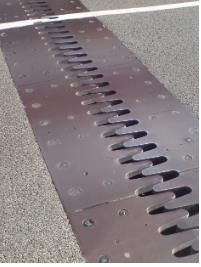
The expansion of alcohol in a thermometer is one of many commonly encountered examples of thermal expansion, the change in size or volume of a given mass with temperature. Hot air rises because its volume increases, which causes the hot air’s density to be smaller than the density of surrounding air, causing a buoyant (upward) force on the hot air. The same happens in all liquids and gases, driving natural heat transfer upwards in homes, oceans, and weather systems. Solids also undergo thermal expansion. Railroad tracks and bridges, for example, have expansion joints to— allow them to freely expand and contract with temperature changes.
What are the basic properties of thermal expansion? First, thermal expansion is clearly related to temperature change. The greater the temperature change, the more a bimetallic strip will bend. Second, it depends on the material. In a thermometer, for example, the expansion of alcohol is much greater than the expansion of the glass containing it.
What is the underlying cause of thermal expansion? As is discussed in Kinetic Theory: Atomic and Molecular Explanation of Pressure and Temperature, an increase in temperature implies an increase in the kinetic energy of the individual atoms. In a solid, unlike in a gas, the atoms or molecules are closely packed together, but their kinetic energy (in the form of small, rapid vibrations) pushes neighboring atoms or molecules apart from each other. This neighbor-to-neighbor pushing results in a slightly greater distance, on average, between neighbors, and adds up to a larger size for the whole body. For most substances under ordinary conditions, there is no preferred direction, and an increase in temperature will increase the solid’s size by a certain fraction in each dimension.
Linear Thermal Expansion—Thermal Expansion in One Dimension
The change in length L is proportional to length L. The dependence of thermal expansion on temperature, substance, and length is summarized in the equation
L = αLT,
where L is the change in length L,T is the change in temperature, and α alpha is the coefficient of linear expansion, which varies slightly with temperature.
lists representative values of the coefficient of linear expansion, which may have units of 1/C or 1/K. Because the size of a kelvin and a degree Celsius are the same, both α and T can be expressed in units of kelvins or degrees Celsius. The equation L = αLT is accurate for small changes in temperature and can be used for large changes in temperature if an average value of α is used.
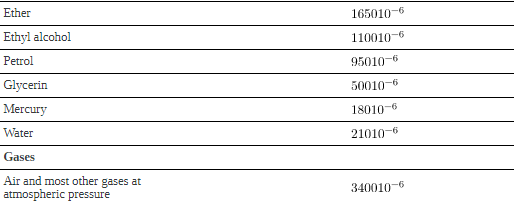
Thermal Expansion in Two and Three Dimensions:
Objects expand in all dimensions, as illustrated in. That is, their areas and volumes, as well as their lengths, increase with temperature. Holes also get larger with temperature. If you cut a hole in a metal plate, the remaining material will expand exactly as it would if the plug was still in place. The plug would get bigger, and so the hole must get bigger too. (Think of the ring of neighboring atoms or molecules on the wall of the hole as pushing each other farther apart as temperature increases. Obviously, the ring of neighbors must get slightly larger, so the hole gets slightly larger).
Thermal Expansion in Two Dimensions:
For small temperature changes, the change in area A is given by
A = 2αAT,
where A is the change in area A,T is the change in temperature, and α alpha is the coefficient of linear expansion, which varies slightly with temperature.
In general, objects expand in all directions as temperature increases. In these drawings, the original boundaries of the objects are shown with solid lines, and the expanded boundaries with dashed lines. (a) Area increases because both length and width increase. The area of a circular plug also increases. (b) If the plug is removed, the hole it leaves becomes larger with increasing temperature, just as if the expanding plug were still in place. (c) Volume also increases, because all three dimensions increase.
Thermal Expansion in Three Dimensions:
The change in volume V is very nearly V = 3αVT . This equation is usually written as
V = βVT,
where β is the coefficient of volume expansion and β = 3α. Note that the values of β beta in are almost exactly equal to 3α.
In general, objects will expand with increasing temperature. Water is the most important exception to this rule. Water expands with increasing temperature (its density decreases) when it is at temperatures greater than 4C(40F). However, it expands with decreasing temperature when it is between +4C and 0C (40F) to 32F. Water is densest at +4C. Perhaps the most striking effect of this phenomenon is the freezing of water in a pond. When water near the surface cools down to 4C it is denser than the remaining water and thus will sink to the bottom. This “turnover” results in a layer of warmer water near the surface, which is then cooled. Eventually the pond has a uniform temperature of 4C. If the temperature in the surface layer drops below 4C, the water is less dense than the water below, and thus stays near the top. As a result, the pond surface can completely freeze over. The ice on top of liquid water provides an insulating layer from winter’s harsh exterior air temperatures. Fish and other aquatic life can survive in 4C water beneath ice, due to this unusual characteristic of water. It also produces circulation of water in the pond that is necessary for a healthy ecosystem of the body of water.
The density of water as a function of temperature. Note that the thermal expansion is actually very small. The maximum density at +4C is only 0.0075% greater than the density at 2C, and 0.012% greater than that at 0C.
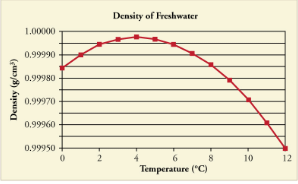
Differences in the thermal expansion of materials can lead to interesting effects at the gas station. One example is the dripping of gasoline from a freshly filled tank on a hot day. Gasoline starts out at the temperature of the ground under the gas station, which is cooler than the air temperature above. The gasoline cools the steel tank when it is filled. Both gasoline and steel tank expand as they warm to air temperature, but gasoline expands much more than steel, and so it may overflow.
This difference in expansion can also cause problems when interpreting the gasoline gauge. The actual amount (mass) of gasoline left in the tank when the gauge hits “empty” is a lot less in the summer than in the winter. The gasoline has the same volume as it does in the winter when the “add fuel” light goes on, but because the gasoline has expanded, there is less mass. If you are used to getting another 40 miles on “empty” in the winter, beware—you will probably run out much more quickly in the summer.
Because the gas expands more than the gas tank with increasing temperature, you can’t drive as many miles on “empty” in the summer as you can in the winter.

Thermal Stress:
Thermal stress is created by thermal expansion or contraction (see Elasticity: Stress and Strain for a discussion of stress and strain). Thermal stress can be destructive, such as when expanding gasoline ruptures a tank. It can also be useful, for example, when two parts are joined together by heating one in manufacturing, then slipping it over the other and allowing the combination to cool. Thermal stress can explain many phenomena, such as the weathering of rocks and pavement by the expansion of ice when it freezes.
Forces and pressures created by thermal stress are typically as great as that in the example above. Railroad tracks and roadways can buckle on hot days if they lack sufficient expansion joints.Power lines sag more in the summer than in the winter, and will snap in cold weather if there is insufficient slack. Cracks open and close in plaster walls as a house warms and cools. Glass cooking pans will crack if cooled rapidly or unevenly, because of differential contraction and the stresses it creates. (Pyrex® is less susceptible because of its small coefficient of thermal expansion.) Nuclear reactor pressure vessels are threatened by overly rapid cooling, and although none have failed, several have been cooled faster than considered desirable. Biological cells are ruptured when foods are frozen, detracting from their taste. Repeated thawing and freezing accentuate the damage. Even the oceans can be affected. A significant portion of the rise in sea level that is resulting from global warming is due to the thermal expansion of sea water.
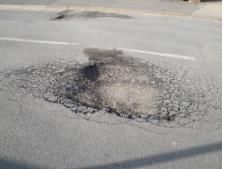
Metal is regularly used in the human body for hip and knee implants. Most implants need to be replaced over time because, among other things, metal does not bond with bone. Researchers are trying to find better metal coatings that would allow metal-to-bone bonding. One challenge is to find a coating that has an expansion coefficient similar to that of metal. If the expansion coefficients are too different, the thermal stresses during the manufacturing process lead to cracks at the coating-metal interface.
Another example of thermal stress is found in the mouth. Dental fillings can expand differently from tooth enamel. It can give pain when eating ice cream or having a hot drink. Cracks might occur in the filling. Metal fillings (gold, silver, etc.) are being replaced by composite fillings (porcelain), which have smaller coefficients of expansion, and are closer to those of teeth.
Check Your Understanding
Two blocks, A and B, are made of the same material. Block A has dimensions lwh = L2LL and Block B has dimensions 2L2L2L. If the temperature changes, what is (a) the change in the volume of the two blocks, (b) the change in the cross-sectional area lw, and (c) the change in the height h of the two blocks?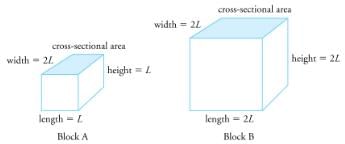
(a) The change in volume is proportional to the original volume. Block A has a volume of L2LL = 2L3. Block B has a volume of 2L2L2L = 8L3 which is 4 times that of Block A. Thus the change in volume of Block B should be 4 times the change in volume of Block A.
(b) The change in area is proportional to the area. The cross-sectional area of Block A is L2L = 2L2 while that of Block B is 2L2L = 4L2 Because cross-sectional area of Block B is twice that of Block A, the change in the cross-sectional area of Block B is twice that of Block A.
(c) The change in height is proportional to the original height. Because the original height of Block B is twice that of A, the change in the height of Block B is twice that of Block A.
Section Summary
- Thermal expansion is the increase, or decrease, of the size (length, area, or volume) of a body due to a change in temperature.
- Thermal expansion is large for gases, and relatively small, but not negligible, for liquids and solids.
- Linear thermal expansion is
L = αLT,
where L is the change in length L, T is the change in temperature, and α is the coefficient of linear expansion, which varies slightly with temperature. - The change in area due to thermal expansion is
A = 2αAT,
where A is the change in area. - The change in volume due to thermal expansion is
V = βVT,
where β is the coefficient of volume expansion and . Thermal stress is created when thermal expansion is constrained.
. Thermal stress is created when thermal expansion is constrained.
|
210 videos|156 docs|94 tests
|
FAQs on Thermal Expansion of Solids and Liquids - Basic Physics for IIT JAM
| 1. What is thermal expansion? |  |
| 2. How does thermal expansion affect solids? |  |
| 3. How does thermal expansion affect liquids? |  |
| 4. What is the coefficient of thermal expansion? |  |
| 5. How is thermal expansion relevant in everyday life? |  |

|
Explore Courses for Physics exam
|

|
 . Thermal stress is created when thermal expansion is constrained.
. Thermal stress is created when thermal expansion is constrained.
















